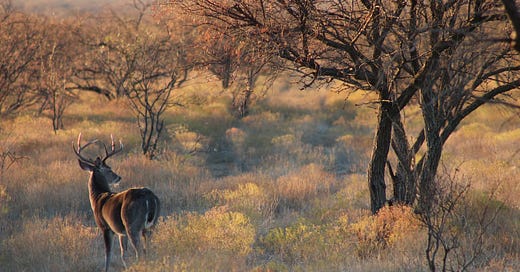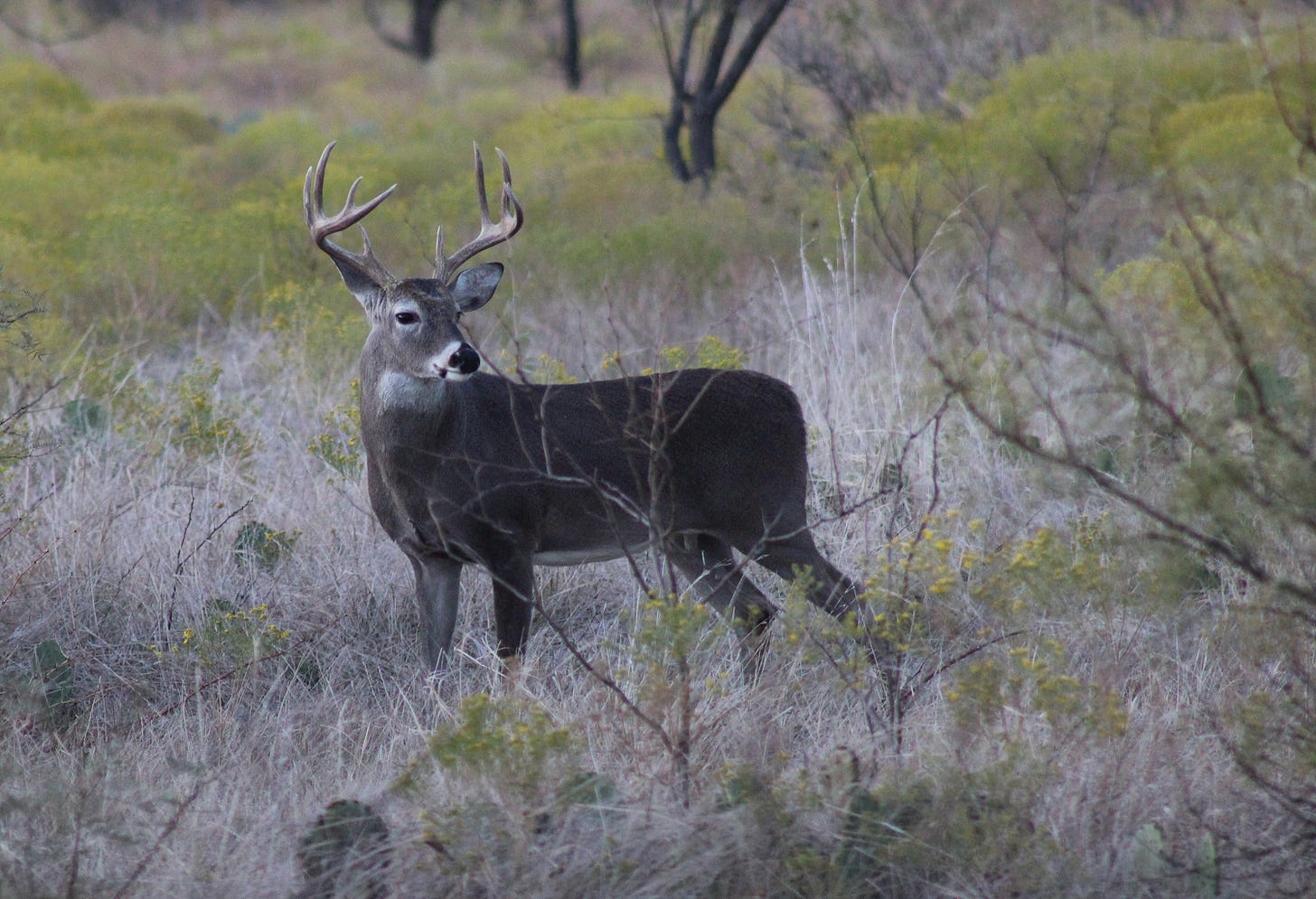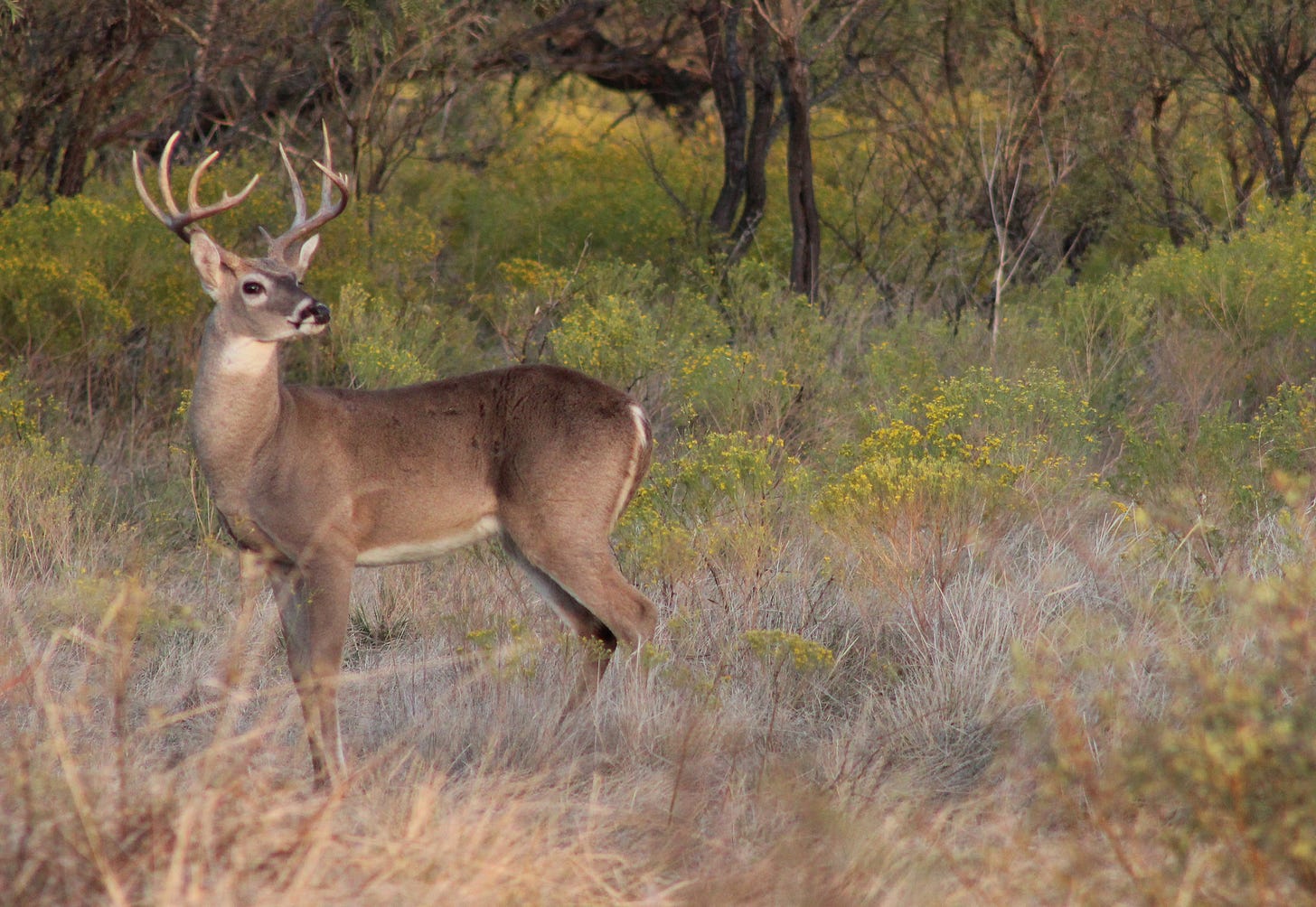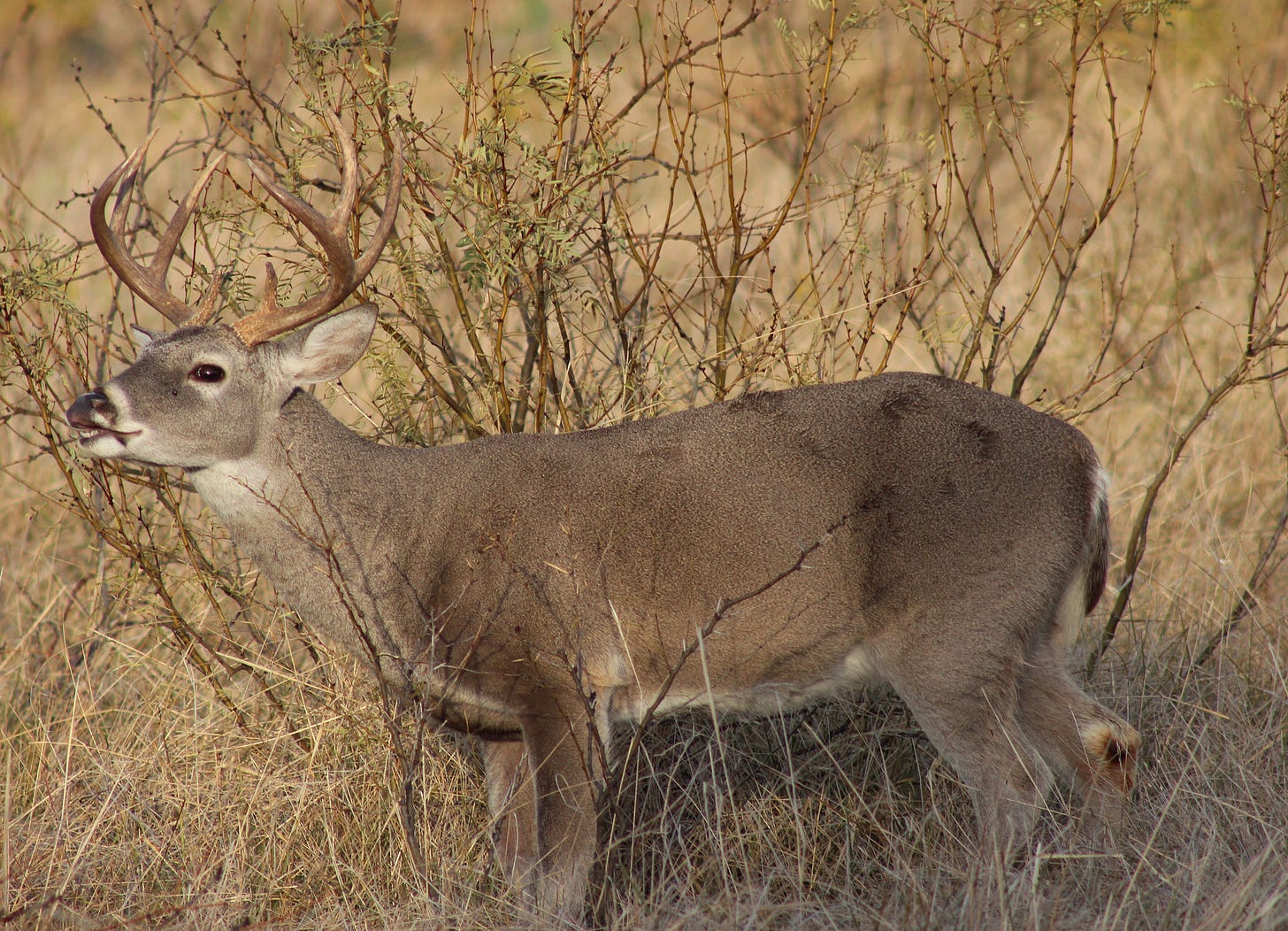The economics of Texas deer hunting
White-tailed deer mean big bucks in more ways than one, providing a multi-billion-dollar impact across the Lone Star State that only continues to rise
Deer hunting in Texas is more than just a barrage of camouflage.
For many folks — hundreds of thousands of us here in the Lone Star State alone — deer hunting is life. From Amarillo to Brownsville north to south, and Texarkana to El Paso east to west — across numerous varied ecosystems all with their own geographic nuances and allures — it’s easy to see why.
Deer hunting is big and booming business.
Deer hunting is time-honored tradition.
Deer hunting is simply time spent afield unlike any other.
It’s also a three-month season that most of us average hunters — and again, there are hundreds of thousands of us — look forward to the instant we leave a lease for the last time in January, closing the book on more invaluable memories as we close that ranch gate.
Make no mistake, deer-hunting success is based on multiple criteria centering on your own personal preferences.
Perhaps you only count achievement in regard to the number of tags you fill or the weight of how much delicious, organic venison you put in the freezer to provide for your family and gracious friends who may not hunt, but certainly enjoy the gifts that your efforts bestow upon them.
Maybe you only hunt for the antlers or for the taking of only mature bucks, those animals that already have helped to spur on multiple generations of future whitetails and have proven to be the epitome of healthy, native deer.
No matter your own discerning inclination, there is no wrong answer in determining success in the deer woods, forests, mottes, canyons or plains of Texas in which you’re blessed to pursue our state’s prime big game animal.
And if you’re like most hunters — myself firmly entrenched on this hill — deer hunting is mainly an excuse to spend time outdoors across any pristine landscape here in the Lone Star State, joining others in the shared search of our state’s No. 1 hunting target.
So, what does deer hunting really mean to Texas?
Beyond the emotions and motivations associated with enjoying the hunt, which can vary and be hard to adequately assess based on subjectivity, you only must inspect the numbers to learn just how significant the impact is objectively. That’s especially true at the local level. Places like Llano, Junction and Mason are just a few of the many dozens of small towns across the state that welcome nonresidents of their communities with open arms, throwing wild game dinners and hunter appreciation events complete with barbecue, all the trimmings and plenty of prize giveaways endowed by local businesses and residents who all enjoy sharing in the land of plenty that continues to provide.
Local business owners revel in seeing GameGuard, Realtree and Mossy Oak from head to toe, lifted pickups and SUVs towing gear-laden trailers, and all those hunters and their families who bring along their wallets beginning with lease preparations in September through February when everything must be secured and packed away for those engaged in the state’s Managed Lands Deer Permit program offering increased tags and more liberal limits.
It’s a fact that those dollars flowing into many communities can make the entire year for small shops. That’s especially true for those who were hit hard and are still somewhat recovering from the pandemic, and others as well in recent years when the hunting might be a bit tougher due to Mother Nature, bringing about fewer visits from hunters.
Texas Deer by the Numbers, Part I
A recent survey conducted by the Texas A&M University Department of Rangeland, Wildlife and Fisheries Management and the Texas A&M Natural Resources Institute helps to shed light on just how valuable white-tailed deer are as a whole to the state of Texas economy. The project was carried out in 2022 and 2023 with the first part of the survey results released to the public in May 2023.
An online survey was sent to a random sampling of 100,000 Texas super-combo license holders and respondents were divided into two groups, as either a hunter or a landowner. In total, roughly 9% of the total responded to dozens of distinct survey questions about everything going into their pursuit from their most recent deer hunting season.
Based on survey estimates as a baseline, researchers then extrapolated the total statewide financial impact of hunters and landowners. Here's a sampling of interesting facts compiled from the first part of the study, which centered on expenditures, as well as profile data for each group:
There are approximately 5.3 million wild deer in Texas and about 103,000 deer in breeding facilities permitted by the Texas Parks and Wildlife Department.
Approximately 555,000 hunters spend nearly $2 billion each year as a whole on white-tailed deer hunting pursuits in Texas while 200,000 landowners spend about $2.5 billion
The top five most common expenditures for hunters are licenses, transportation, meals, shooting equipment and feed/feeders. The five largest are outfitter/guide fees, lease fees, lodging, land management and feed/feeders; the average lease fee was $2,904 and each hunter spends a total of $3,348 annually on deer hunting.
More than half (52%) hunt land owned by family or friends. Another portion (41%) hunt on leases and the rest use public land (5%) and outfitters (2%).
Landowners spend an average of $18,812 and bring in $20,658 in revenue. The top five most common expenses are supplemental feed, property taxes, land management, equipment maintenance and capital improvements. The five largest are payroll, land management, supplemental feed, hospitality and property taxes. Landowners spend an average of $3,593 per year on supplemental feed.
The vast majority of landowners (95%) described their deer herds as “100% native” with no influence from supplemental deer from breeders.
About 70% of Texas deer hunters do not own land, and 45% of those hunters reported leasing land or hiring outfitters to deer hunt.
Texas Deer by the Numbers, Part II
The results from the second part of the joint Texas A&M survey were released in November 2023 – just in time for another deer season – and centered on direct economics involving hunters and landowners. Estimates from that portion of the survey also yielded numerous pertinent figures, including just how huge of an impact Texas deer hunting has at the local, state and even federal level:
Texas deer hunters generate an estimated $4.6 billion in total economic output each year while landowners who support deer hunting generate about $5 billion in annual economic output.
White-tailed deer hunting supports 23,726 jobs resulting in $1.3 billion in labor income and $446 million in annual tax revenues ($237 million federal, $114 million local and $95 million to the state).
Each hunter has an average economic impact of about $6,000 per year while hunters spend an estimated $462 million on travel while deer hunting.
Landowners who support deer hunting employ about 35,000 people, provide $707 million in labor income and generate more than $90 million in tax revenue ($60 million federal, $31 million state and local).
Texas deer hunting is conservation
Just think about how many pallets of bagged corn changes hands over the course of the year — and that’s just one small aspect of the pastime — and you can somewhat envision the wide-ranging scope of Texas deer hunting.
All that funding has a trickle-down effect, helping to pump hundreds of millions of dollars into our local state economy each fall and winter. While that dollar amount includes valuable funds headed to outfitters, mom-and-pop shops and those making a direct living off the hunting industry, the federal taxes generated by the overall industry end up going back into state coffers earmarked for needed resource protections and improvements.
In that aspect, hunting is conservation, with a direct correlation to improving habitat and in some cases access and opportunities.
The U.S. Fish & Wildlife Service annually distributes revenue to each state’s wildlife agency through the Pittman-Robertson Wildlife Restoration program, with funds coming from excise taxes on the sale of everything from sporting firearms and ammunition to archery equipment.
That figure in 2023 coming back to the Lone Star State was nearly $55 million for wildlife restoration efforts — the highest figure in the country. Pittman-Robertson funds allow the Texas Parks and Wildlife Department’s Wildlife Division to offer many services, including technical guidance to private landowners who control roughly 95% of wildlife habitat in Texas, TPWD surveys and research for development of hunting regulations, operation and management of Wildlife Management Areas, and conducting research and developing techniques for managing wildlife populations and wildlife habitat.
Hunters also play a vital role in that deer management at the statewide level, which also means a lot, too. Those hundreds of thousands of hunters are the main mechanism by which TPWD influences overall deer numbers, buck-to-doe ratios and various herd genetics, while helping to increase or reduce populations based on selective harvest.
The clear example of this conservation role and management framework is the antler restriction move implemented in a half-dozen Post Oak region counties in the late 1990s. They were designed to improve the age structure of buck herds, increase the opportunity to harvest those bucks and encourage better habitat management. For the most part, that framework has been wildly successful, and the restrictions are now in place in dozens more counties in the Post Oak, Pineywoods and northern coastal prairie regions.
While it’s easy to quantify the economic and management impacts of what deer hunting means to Texas, it’s just as simple to see numerous other ways hunters contribute. In many regards, deer hunting also is about giving back, whether it’s hunting organizations and local clubs offering community fundraising events and field days that get families into the outdoors — something that’s vital to our hunting heritage — or providing high-quality, lean meat for the state’s Hunters for the Hungry program.
Alan Cain, the current big game program director and longtime former deer program leader for the Texas Parks and Wildlife Department, may have provided the best answers on quantity and quality when it comes to both deer hunting and enjoying the outdoor pursuit in general.
“Regardless of where you hunt in Texas, there’s always a good chance you’ll see a great, quality buck each season,” he noted. “Whether you take a deer or not, spending time outdoors with your family and friends is worth the effort, much better than spending a day at the office or a weekend on the couch.”
How much is Texas deer hunting really worth?
Dr. James Kroll — long known in Texas and across the country as “Dr. Deer” — has decades of experience in all things whitetail management. The longtime director of the Institute for White-tailed Deer Management and Research at Stephen F. Austin State University said the numerical value of deer hunting based on the Texas A&M research can be calculated based on the estimates of more than 800,000 deer being taken by hunters across 2022-23 frameworks.
“Simplistically, the average whitetail deer harvested in Texas cost a whopping $5,194. If we are more generous and calculate it based on the entire deer population, it drops to $782,” he noted. “At any valuation, it suggests that a high value is placed on whitetails in Texas. And this does not include the cost of acquiring land with a primary use of wildlife management. Twenty years ago, we did a study here in East Texas, which used the average lease fee and harvest rate, finding that hunters on a lease actually paid more for their buck than they would have at a per animal trophy operation!”
Kroll notes that times have certainly changed in terms of the Texas deer hunting landscape, most notably the focus on growing quality whitetails and also that fact that prices have continued to go up across the board when pursuing our state’s top big game quarry.
In closing, he offered a summation that likely resonates with most hunters, regardless of where they call home or where they’re hunting.
“After more than 50 years of living and working with whitetails, as well as 60 years of hunting them, the true value of a whitetail is priceless! This is because it is not limited to what someone spends on deer hunting or managing deer on their land,” he noted. “The real value lies in what we get back from the experiences, what we do for the land, what we do for the next generation, and what we do for the white-tailed deer. “Again, it’s priceless. You and what you get from deer hunting is the truly valuable commodity!”







